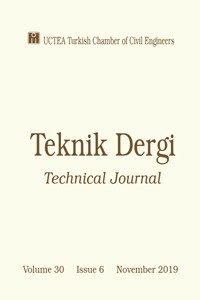Abstract
In this study, a hypothetical tall building structure consisting of two towers and a common podium is analyzed considering effects of interaction between the towers due to connected podium floors. Interaction effects on the podium level are included in the analyses by embracing either an upper bound or lower bound approach, assigning fixed or free end restraints at the continuous boundaries of single tower models, respectively. Response of single tower models are then compared with the response obtained from combined model which includes both of the towers as well as the common podium and basements. Obtained results indicate that, in both linear and nonlinear analyses, single tower models with fixed end restraints overestimate internal forces at the podium floors, although to a reasonable extent.
References
- Qi Xiaoxuan, Chen Shuang, 1996, “Dynamic Behavior and Seismic Design of Structural Systems Having Multiple High-rise Towers on a Common Podium,Paper No. 1101”, Sociedat Mexicana De Ingenieria Sismica, Eleventh World Conference on Earthquake Engineering, Acapulco, Mexico, June’23-28, 1996, Elsevier Science Ltd., California.
- Behnamfar F., Dorafshan S., Taheri A., Hashemi B. H., 2015, “A Method for Rapid Estimation of Dynamic Coupling and Spectral Responses of Connected Adjacent Structures”, The Structural Design of Tall and Special Buildings, Vol. 25, pp: 605-625.
- Applied Technology Council, 2010, Modeling and Acceptance Criteria for Seismic Design and Analysis of Tall Buildings, ATC72-1, Pacific Earthquake Engineering Research Center, California.
- Los Angeles Tall Buildings Structural Design Council, 2015, An Alternative Procedure for Seismic Analysis and Design of Tall Buildings Located in the Los Angeles Region, Los Angeles Tall Buildings Structural Design Council, California.
- Pacific Earthquake Engineering Research Center, 2010, Guidelines for Performance-based Seismic Design of Tall Buildings, Report PEER-2010/05, Pacific Earthquake Engineering Research Center, University of California.
- Turkish Building Earthquake Code, 2018, Specifications for Design of Buildings under Earthquake Action, Disaster and Emergency Management Presidency, Ankara.
- ETABS Ultimate v16.1.0, 2017, Extended 3D Analysis of Building Structures, Computers and Structures, Inc., California, USA.
- Turkish Standards Institute, 2000, Requirements for Design and Construction of Reinforced Concrete Structures, TS500, Turkish Standards Institute, Ankara Turkey.
- Turkish Standards Institute, 1997, Design Loads for Buildings, TS498, Turkish Standards Institute, Ankara.
- Computer and Structures, Inc., 2011, Perform 3D V6.0.0: Nonlinear Analysis and Performance Assessment for 3D Structures, California, USA.
- ASCE/SEI Seismic Rehabilitation Committee, 2014, Seismic Evaluation and Retrofit of Existing Buildings, ASCE/SEI41-13, American Society of Civil Engineers, Reston, VA.
- Powell, G. H., 2010, Modeling for Structural Analysis, Behavior and Basics, Computers and Structures Inc. Berkeley, California.
- Disaster and Emergency Management Presidency, 2017, Turkish Earthquake Hazard Map https://testtdth.afad.gov.tr/, accessed at June 2017.
- Pasific Earthquake Engineering Research Center, 2013, Next Generation Attenuation-West2, http://ngawest2.berkeley.edu/, accessed at June 2017.
Abstract
In this study, a hypothetical tall building structure
consisting of two towers and a common podium is analyzed considering effects of
interaction between the towers due to connected podium floors. Interaction
effects on the podium level are included in the analyses by embracing either an
upper bound or lower bound approach, assigning fixed or free end restraints at
the continuous boundaries of single tower models, respectively. Response of
single tower models are then compared with the response obtained from combined
model which includes both of the towers as well as the common podium and
basements. Obtained results indicate that, in both linear and nonlinear
analyses, single tower models with fixed end restraints overestimate internal
forces at the podium floors, although to a reasonable extent.
References
- Qi Xiaoxuan, Chen Shuang, 1996, “Dynamic Behavior and Seismic Design of Structural Systems Having Multiple High-rise Towers on a Common Podium,Paper No. 1101”, Sociedat Mexicana De Ingenieria Sismica, Eleventh World Conference on Earthquake Engineering, Acapulco, Mexico, June’23-28, 1996, Elsevier Science Ltd., California.
- Behnamfar F., Dorafshan S., Taheri A., Hashemi B. H., 2015, “A Method for Rapid Estimation of Dynamic Coupling and Spectral Responses of Connected Adjacent Structures”, The Structural Design of Tall and Special Buildings, Vol. 25, pp: 605-625.
- Applied Technology Council, 2010, Modeling and Acceptance Criteria for Seismic Design and Analysis of Tall Buildings, ATC72-1, Pacific Earthquake Engineering Research Center, California.
- Los Angeles Tall Buildings Structural Design Council, 2015, An Alternative Procedure for Seismic Analysis and Design of Tall Buildings Located in the Los Angeles Region, Los Angeles Tall Buildings Structural Design Council, California.
- Pacific Earthquake Engineering Research Center, 2010, Guidelines for Performance-based Seismic Design of Tall Buildings, Report PEER-2010/05, Pacific Earthquake Engineering Research Center, University of California.
- Turkish Building Earthquake Code, 2018, Specifications for Design of Buildings under Earthquake Action, Disaster and Emergency Management Presidency, Ankara.
- ETABS Ultimate v16.1.0, 2017, Extended 3D Analysis of Building Structures, Computers and Structures, Inc., California, USA.
- Turkish Standards Institute, 2000, Requirements for Design and Construction of Reinforced Concrete Structures, TS500, Turkish Standards Institute, Ankara Turkey.
- Turkish Standards Institute, 1997, Design Loads for Buildings, TS498, Turkish Standards Institute, Ankara.
- Computer and Structures, Inc., 2011, Perform 3D V6.0.0: Nonlinear Analysis and Performance Assessment for 3D Structures, California, USA.
- ASCE/SEI Seismic Rehabilitation Committee, 2014, Seismic Evaluation and Retrofit of Existing Buildings, ASCE/SEI41-13, American Society of Civil Engineers, Reston, VA.
- Powell, G. H., 2010, Modeling for Structural Analysis, Behavior and Basics, Computers and Structures Inc. Berkeley, California.
- Disaster and Emergency Management Presidency, 2017, Turkish Earthquake Hazard Map https://testtdth.afad.gov.tr/, accessed at June 2017.
- Pasific Earthquake Engineering Research Center, 2013, Next Generation Attenuation-West2, http://ngawest2.berkeley.edu/, accessed at June 2017.
Details
| Primary Language | English |
|---|---|
| Subjects | Civil Engineering |
| Journal Section | Articles |
| Authors | |
| Publication Date | November 1, 2019 |
| Submission Date | October 4, 2018 |
| Published in Issue | Year 2019 Volume: 30 Issue: 6 |


